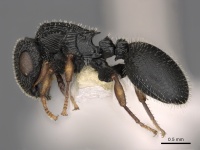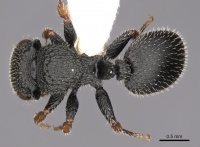Cataulacus cestus
| Cataulacus cestus | |
|---|---|

| |
| Scientific classification | |
| Kingdom: | Animalia |
| Phylum: | Arthropoda |
| Class: | Insecta |
| Order: | Hymenoptera |
| Family: | Formicidae |
| Subfamily: | Myrmicinae |
| Tribe: | Crematogastrini |
| Genus: | Cataulacus |
| Species: | C. cestus |
| Binomial name | |
| Cataulacus cestus Bolton, 1982 | |
Nothing is known about the biology of Cataulacus cestus.
Identification
A member of the tenuis group.
Keys including this Species
Distribution
Latitudinal Distribution Pattern
Latitudinal Range: 1.45° to 1.45°.
| North Temperate |
North Subtropical |
Tropical | South Subtropical |
South Temperate |
- Source: AntMaps
Distribution based on Regional Taxon Lists
Afrotropical Region: Democratic Republic of Congo (type locality).
Distribution based on AntMaps
Distribution based on AntWeb specimens
Check data from AntWeb
Countries Occupied
| Number of countries occupied by this species based on AntWiki Regional Taxon Lists. In general, fewer countries occupied indicates a narrower range, while more countries indicates a more widespread species. |

|
Estimated Abundance
| Relative abundance based on number of AntMaps records per species (this species within the purple bar). Fewer records (to the left) indicates a less abundant/encountered species while more records (to the right) indicates more abundant/encountered species. |

|
Biology
Castes
Nomenclature
The following information is derived from Barry Bolton's Online Catalogue of the Ants of the World.
- cestus. Cataulacus cestus Bolton, 1982: 360 (w.) DEMOCRATIC REPUBLIC OF CONGO.
- Type-material: holotype worker, 4 paratype workers.
- Type-locality: holotype Democratic Republic of Congo (“B. Congo”): Ituri Forest, Beni-Irumu, ii.1948, no. 2122 (N.A. Weber); paratypes: 1 worker with same data, 1 worker with same data but no, 2120, 2 workers with same data but no. 2119.
- Type-depositories: MCZC (holotype); BMNH, MCZC (paratypes).
- Status as species: Bolton, 1995b: 137.
- Distribution: Democratic Republic of Congo.
Unless otherwise noted the text for the remainder of this section is reported from the publication that includes the original description.
Description
Worker
Holotype. TL 4.0, HL 1.00, HW 0.99, CI 99, EL, 0.45, OI 45, SL 0.48, SI 48, PW 0.76, AL 1.10.
Sides of head behind eyes denticulate, terminating in a larger denticle at the occipital corner. Occipital crest absent but the occipital surface shallowly concave above the foramen and meeting the dorsum in an angle, the two surfaces not evenly rounded together. Occipital margin unarmed except for a denticle or short tooth close to the one at the corner. Eyes relatively small, OI < 50. With the alitrunk in profile the dorsum evenly shallowly convex between the more steeply sloped anterior portion of the pronotum and the base of the propodeal spines. Pronotal and propodeal surfaces beset with small peaks or tubercles in profile, the mesonotal dorsum also having such peaks but they are here more scattered and much lower, having the appearance of minute irregularities in the outline. Mesokatepisternal tooth small. Metapleural lobes rounded. Propodeal spines in profile short, more or less straight, only very slightly elevated. Alitrunk in dorsal view with the pronotal corners denticulate, the lateral marginations of the pronotum behind the corners with 6-7 sharp triangular denticles projecting laterally. Sides of mesonotum with 1-2 small denticles and sides of propodeum also with 1-2, occurring on the convexity over the spiracle. Propodeal spines short and broad, widely divergent. Petiole node in profile rising to an acute peak dorsally. The subpetiolar process with a rounded and slightly prominent anteroventral lobe and a triangular projecting posteroventral tooth or heel; the ventral surface between the two angles feebly concave. Postpetiole in profile high, its dorsal surface with a number of conspicuous peaks or tubercles and its ventral process short-digitiform. Dorsum of head irregularly reticulate-rugose, the meshes of varying size and the rugae low and rounded. Many of the reticular meshes incomplete or with their walls broken. Ground-sculpture within the meshes a very fine superficial shagreening or granular roughening of the surface, not reticulate-punctate. Dorsal alitrunk irregularly reticulate-rugose everywhere, many of the rugular meshes incomplete or broken and very irregular in shape. Ground-sculpture finely reticulate-punctate to densely shagreened. Petiole node in dorsal view strongly longitudinally rugose, the rugae converging posteriorly. Postpetiole irregularly rugulose and finely densely punctulate. First gastral tergite coarsely and densely reticulate-punctate everywhere, the whole surface also loosely covered with anastomosing fine irregular superficial rugulae which are strongest basally and fade out apically on the sclerite. First gastral sternite similarly sculptured. Entire dorsum of head covered with a dense pelt of short straight erect bristly blunt hairs which are cylindrical to subcylindrical in shape. All remaining dorsal surfaces of body with similar dense bristly pilosity. Colour uniform black; the scapes, tibiae and tarsi dull yellow.
Paratypes. TL 4.0-4.1, HL 0.98-1.02, HW 0.98-1.02, CI 98-100, EL 0.45-0.48, OI 46-47, SL 0.48-0.50, SI 49-51, PW 0.76-0.86, AL 1.08-1.16 (4 measured).
As holotype but in some the gastral rugulae are less strongly developed and in one the gastral rugulae are effaced. The ventral surface of the subpetiolar process may be more strongly concave than is the case with the holotype.
Type Material
Holotype worker, Zaire (B. Congo on data label); Ituri For., Beni-Irumu, ii.1948, no. 2122 (N. A. Weber) (Museum of Comparative Zoology). Paratypes. 1 worker with same data as holotype; 1 worker with same data as holotype but no. 2120; 2 workers with same data as holotype but no. 2119. (MCZ; The Natural History Museum).

